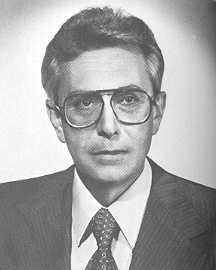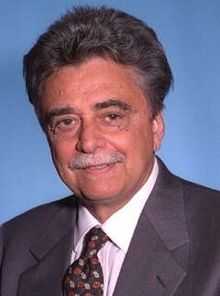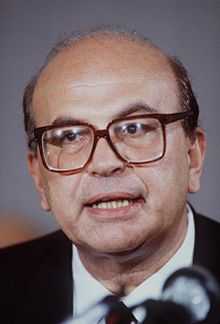Italian general election, 1992
Italian general election, 1992

|
|
|
|
|

|
| Legislative election results map. Light Blue denotes provinces with a Christian Democratic plurality, Red denotes those with a Democratic Socialist plurality, Green denotes those with a Lega Nord plurality, Gray and Brown denotes those with a Regionalist plurality. |
|
General elections were held in Italy on April 5, 1992 for the 11th Parliament of the Republic.[3] They were the first without the traditionally second most important political force in Italian politics, the Italian Communist Party (PCI), which had been disbanded in 1991. It was replaced by a more social-democratic oriented force, the Democratic Party of the Left (PDS), and by a minority entity formed by members who did not want to renounce the communist tradition, the Communist Refoundation Party (PRC). However, put together they gained around 4% less than what the already declining PCI had obtained in the 1987 Italian general election, despite PRC had absorbed the disbanded Proletarian Democracy (DP).
The other major feature was the sudden rise of the federalist Lega Nord, which increased its vote from 0.5% of the preceding elections to more than 8%, increasing from a single member both in the Chamber and the Senate to 55 and 25, respectively. The onda lunga ("long wave") of Bettino Craxi's now centrist-oriented Italian Socialist Party, which in the past elections had been forecast next to overcome PCI, seemed to stop. Christian Democracy and the other traditional government parties, with the exception of the Republicans and the Liberals, also experienced a slight decrease in their vote.
Electoral system
The pure party-list proportional representation had traditionally become the electoral system for the Chamber of Deputies. Italian provinces were united in 32 constituencies, each electing a group of candidates. At constituency level, seats were divided between open lists using the largest remainder method with Imperiali quota. The remaining votes and seats were transferred at national level, where they were divided using the Hare quota, and automatically distributed to best losers into the local lists.
For the Senate, 237 single-seat constituencies were established, even if the assembly had risen to 315 members. The candidates needed a landslide victory of two thirds of votes to be elected, a goal which could be reached only by the German minorities in South Tirol. All remained votes and seats were grouped in party lists and regional constituencies, where a D'Hondt method was used: inside the lists, candidates with the best percentages were elected.
Parties and leaders
| Party |
Ideology |
Leader |
|
Christian Democracy (DC) |
Christian democracy, Popularism |
Arnaldo Forlani |
|
Democratic Party of the Left (PDS) |
Democratic socialism, Post-Communism |
Achille Occhetto |
|
Italian Socialist Party (PSI) |
Social democracy, Social liberalism |
Bettino Craxi |
|
Lega Nord (LN) |
Regionalism, Right-wing populism |
Umberto Bossi |
|
Communist Refoundation Party (PRC) |
Communism, Eurocommunism |
Sergio Garavini |
|
Italian Social Movement (MSI) |
Neo-Fascism, Italian nationalism |
Gianfranco Fini |
|
Italian Republican Party (PRI) |
Social liberalism, Centrism |
Giorgio La Malfa |
|
Italian Liberal Party (PLI) |
Liberalism, Conservatism |
Renato Altissimo |
|
Federation of the Greens (FdV) |
Green politics, Eco-socialism |
Carlo Ripa di Meana |
|
Italian Democratic Socialist Party (PSDI) |
Social democracy, Centrism |
Franco Nicolazzi |
|
The Network (LR) |
Anti-corruption, Ecologism |
Leoluca Orlando |
|
Pannella List (LP) |
Radicalism, Anti-clericalism |
Marco Pannella |
Results
Chamber of Deputies

Chamber of Deputies after the election.
| Party |
Votes |
% |
Seats |
+/– |
|---|
|
Christian Democracy | 11,640,265 | 29.66 | 206 | –28 |
|
Democratic Party of the Left | 6,321,084 | 16.11 | 107 | –70 |
|
Italian Socialist Party | 5,343,930 | 13.62 | 92 | –2 |
|
Lega Nord | 3,396,012 | 8.65 | 55 | +54 |
|
Communist Refoundation Party | 2,204,641 | 5.62 | 35 | New |
|
Italian Social Movement | 2,107,037 | 5.37 | 34 | –1 |
|
Italian Republican Party | 1,722,465 | 4.39 | 27 | +6 |
|
Italian Liberal Party | 1,121,264 | 2.86 | 17 | +6 |
|
Federation of the Greens | 1,093,995 | 2.79 | 16 | +3 |
|
Italian Democratic Socialist Party | 1,064,647 | 2.71 | 16 | –1 |
|
The Network | 730,171 | 1.86 | 12 | New |
|
Pannella List | 485,694 | 1.24 | 7 | –6 |
|
Yes Referendum | 485,694 | 0.81 | 0 | New |
|
Pensioners' Party | 485,694 | 0.81 | 0 | New |
|
Other Leagues | 220,559 | 0.56 | 0 | New |
|
South Tyrolean People's Party | 198,447 | 0.51 | 3 | – |
|
Hunting, Fishing, Environment | 192,799 | 0.49 | 0 | – |
|
Federalism–Pensioners Living Men (UV–PSd'Az–SSK–UfS–Others) | 154,621 | 0.39 | 1 | New |
|
Lega Autonomia Veneta | 152,301 | 0.39 | 1 | New |
|
Housewives–Pensioners League | 133,717 | 0.34 | 0 | New |
|
Autonomist Lists | 94,583 | 0.24 | 0 | – |
|
Southern Action League | 53,759 | 0.14 | 0 | New |
|
Autonomous Veneto | 49,035 | 0.12 | 0 | New |
|
Federalist Greens | 42,647 | 0.11 | 0 | New |
|
Aosta Valley | 41,404 | 0.11 | 1 | – |
|
Others | 116,007 | 0.30 | 0 | – |
| Invalid/blank votes | 2,232,489 | – | – | – |
| Total | 41,479,764 | 100 | 630 | 0 |
| Registered voters/turnout | 47,486,964 | 87.35 | – | – |
| Source: Ministry of the Interior |
Senate of the Republic

Senate after the election.

Regional pluralities in Senate
| Party |
Votes |
% |
Seats |
+/– |
|---|
|
Christian Democracy | 9,088,494 | 27.27 | 107 | –18 |
|
Democratic Party of the Left | 5,682,888 | 17.05 | 64 | –37 |
|
Italian Socialist Party | 4,523,873 | 13.57 | 49 | +13 |
|
Lega Nord | 2,732,461 | 8.20 | 25 | +24 |
|
Communist Refoundation Party | 2,171,950 | 6.52 | 20 | New |
|
Italian Social Movement | 2,171,215 | 6.51 | 16 | – |
|
Italian Republican Party | 1,565,142 | 4.70 | 10 | +2 |
|
Federation of the Greens | 1,027,303 | 3.08 | 4 | +3 |
|
Italian Liberal Party | 939,159 | 2.82 | 4 | +1 |
|
Italian Democratic Socialist Party | 853,895 | 2.56 | 3 | –2 |
|
Yes Referendum | 332,318 | 1.00 | 0 | New |
|
The Network | 239,868 | 0.72 | 3 | New |
|
Pensioners' Party | 215,889 | 0.65 | 0 | New |
|
Federalism–Pensioners Living Men (UV–PSd'Az–SSK–UfS–Others) | 174,713 | 0.52 | 1 | New |
|
South Tyrolean People's Party | 168,113 | 0.50 | 3 | +1 |
|
Pannella List | 166,708 | 0.50 | 0 | –3 |
|
For Calabria | 143,976 | 0.43 | 2 | New |
|
Lega Autonomia Veneta | 142,446 | 0.43 | 1 | New |
|
Housewives-Pensioners League | 134,327 | 0.40 | 0 | New |
|
Lega Alpina Lumbarda | 119,153 | 0.36 | 1 | New |
|
Hunting, Fishing, Environment | 116,395 | 0.35 | 0 | – |
|
Autonomist Lists | 95,687 | 0.29 | 0 | – |
|
Autonomous Veneto | 50,938 | 0.15 | 0 | New |
|
Southern Action League | 49,769 | 0.15 | 0 | New |
|
For Molise | 48,352 | 0.15 | 1 | New |
|
Federalist Greens | 47,051 | 0.14 | 0 | New |
|
Aosta Valley | 34,150 | 0.10 | 1 | – |
|
Others | 151,170 | 0.45 | 0 | – |
| Invalid/blank votes | 2,409,646 | – | – | – |
| Total | 35,651,621 | 100 | 315 | 0 |
| Registered voters/turnout | 41,022,758 | 86.9 | – | – |
| Source: Ministry of the Interior |
References
- ↑ Members of PDS parliamentary groups after the disbandment of the Communist Party.
- ↑ Due to impossibility of direct confrontation cause the disbandment of the Communist Party, the percentage refers to the empiric sum of PDS and PRC in 1992, and the result of PCI and DP in 1987.
- ↑ Nohlen, D & Stöver, P (2010) Elections in Europe: A data handbook, p1048 ISBN 978-3-8329-5609-7
External links






